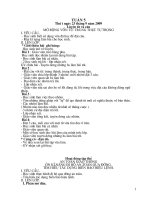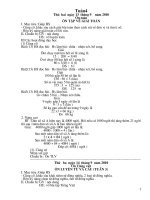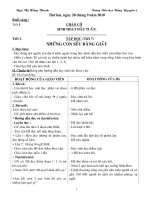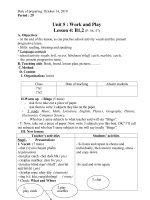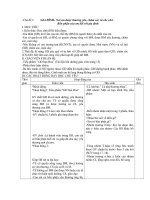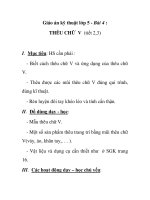- Trang chủ >>
- Mầm non - Tiểu học >>
- Lớp 5
5 2 4 saving endangered species (life science)
Bạn đang xem bản rút gọn của tài liệu. Xem và tải ngay bản đầy đủ của tài liệu tại đây (5.23 MB, 14 trang )
Suggested levels for Guided Reading, DRA,™
Lexile,® and Reading Recovery™ are provided
in the Pearson Scott Foresman Leveling Guide.
Genre
Expository
nonfiction
Comprehension
Skills and Strategy
• Fact and Opinion
• Cause and Effect
• Ask Questions
Life Science
Text Features
•
•
•
•
Captions
Headings
Glossary
Annotated Map
Scott Foresman Reading Street 5.2.4
ISBN 0-328-13528-3
ì<(sk$m)=bdfci < +^-Ä-U-Ä-U
by Catherine Podojil
Reader Response
1. This book is nonfiction. That means most of it is fact,
with little opinion. Find an opinion in the book.
2. Using a graphic organizer like the one below, write
down what questions you have about India’s Wild
Lands Elephant Corridor Project.
W
What We
Want to Know
by
Catherine Podojil
3. Go to the Glossary. Review the definition of
conservationists. Name some activities you participate
in that make you a conservationist.
4. What is something you learned from the map found
on page 18?
Editorial Offices: Glenview, Illinois • Parsippany, New Jersey • New York, New York
Sales Offices: Needham, Massachusetts • Duluth, Georgia • Glenview, Illinois
Coppell, Texas • Ontario, California • Mesa, Arizona
Why do species become extinct?
Every effort has been made to secure permission and provide appropriate credit for
photographic material. The publisher deeply regrets any omission and pledges to
correct errors called to its attention in subsequent editions.
Unless otherwise acknowledged, all photographs are the property of Scott Foresman,
a division of Pearson Education.
Photo locators denoted as follows: Top (T), Center (C), Bottom (B), Left (L), Right (R),
Background (Bkgd)
Opener: Brand X Pictures; 1 Brand X Pictures; 3 (B) Brand X Pictures; 4 (C) Digital
Vision, (BC) Getty Images; 5 (BL, BR) Getty Images; 6 ©DK Images; 7 (BL) Sullivan &
Rogers/Bruce Coleman Inc., (C) Getty Images; 8 (CL) Getty Images, (B) Digital Stock;
9 (B) Digital Vision, (CR) Getty Images; 10 Digital Vision; 11 Getty Images; 12 Digital
Vision; 13 Photo Researchers, Inc.; 14 (C, B) Digital Vision; 15 Getty Images; 16 Getty
Images; 17 (BL, C) Getty Images; 18–19 Toyohiro Yamada/Getty Images; 20 (CL) Digital
Stock, (B) Flat Earth; 21 (BR) Digital Vision; 22 (BL) Brand X Pictures, (BR) Getty Images
Over time many types, or species, of animals and
plants have become extinct. When a species becomes
extinct, none of its kind ever exist again. This
happens for many reasons. For example, two animal
species may eat the same food, but if one species is
a better hunter and can find more food, then the
other species may not get enough food to survive.
Also, some animals survive by eating only one kind of
food, and as a result can die off if that food source
suddenly becomes scarce. This means that a dramatic
change in climate that killed a species of plant would
also kill the animal species that ate only that plant.
You may have heard the theory that many
scientists have about how the dinosaurs became
extinct. About 65 million years ago, a giant asteroid
hit Earth, sending tons of dust and rock flying into
the air and blocking out some of the Sun’s rays. Many
scientists believe that without enough energy from
the Sun, plants everywhere died. The dinosaurs that
depended on those plants for food all died because
they had no more to eat, and without plant eaters,
the meat-eating dinosaurs also became extinct.
Dinosaur extinction was
caused by natural events.
ISBN: 0-328-13528-3
Copyright © Pearson Education, Inc.
All Rights Reserved. Printed in the United States of America. This publication is
protected by Copyright, and permission should be obtained from the publisher
prior to any prohibited reproduction, storage in a retrieval system, or transmission
in any form by any means, electronic, mechanical, photocopying, recording, or
likewise. For information regarding permission(s), write to: Permissions Department,
Scott Foresman, 1900 East Lake Avenue, Glenview, Illinois 60025.
2 3 4 5 6 7 8 9 10 V0G1 14 13 12 11 10 09 08 07 06 05
3
Extinction Today
According to the latest calculations by scientists,
upwards of forty thousand species of plants and
animals are now becoming extinct each year. It’s
hard to imagine forty thousand kinds of mammals,
birds, amphibians, reptiles, insects, flowers, and trees
disappearing forever! Many of these species do not
become extinct because of natural events; rather,
they become extinct because of human actions.
People cut down forests to build homes, roads,
businesses, and farms. In this way many species of
animals and plants lose their homes, or habitats. The
loss of an animal’s habitat can lead to extinction.
Humans also destroy habitats by polluting the land,
water, and air, which are also called environments.
Furthermore, the chemicals and plants that we
use can hurt plants and animals. As the number
of humans grows, we use more land and make
more pollution, driving more and more species to
extinction.
Logging (far left), pollution
(middle), and drilling for oil
(below) all cause habitat loss.
4
5
A Lesson Learned
In the 1800s there were billions of passenger
pigeons in North America. They flew in flocks of
millions that were up to three hundred miles long!
The speed at which the passenger pigeons flew,
estimated at sixty miles an hour, was also amazing.
The birds migrated from Canada to areas in the
southeastern United States, including parts of Texas,
Louisiana, Alabama, Georgia, and Florida.
In Wayne County, New York, a local resident
described passenger pigeons in flight by saying,
“There would be days and days when the air was
alive with them . . . Flocks stretched as far as a person
could see. . . .“ No one could imagine the passenger
pigeon becoming extinct.
But that is exactly what happened. The passenger
pigeon ate mostly nuts from beech and oak trees. In
the 1800s huge oak and beech forests were cut down
for fuel and lumber. Hunters also killed millions of
the birds for food and to sell.
Conservationists tried to stop the overhunting,
but people ignored the laws. The few pigeons left
were put into a breeding program, but this failed
because the remaining population was too small
to breed successfully. Martha, the last passenger
pigeon on Earth, died in 1914 at the Cincinnati Zoo.
The passenger pigeon was
probably the most common
bird in the world. Now there
isn’t a single one anywhere
on Earth.
6
7
What can people do?
During the late twentieth century, people became
worried by the fact that so many species were in
danger of becoming extinct. Conservationists began
to call for protections to preserve species that were
at risk. In response, in 1973, the U.S. Congress passed
the Endangered Species Act. This act protects certain
animals and plants from hunting, collecting, and
other harmful activities.
Two kinds of species are protected under the
act. Endangered species are those that scientists
believe will become extinct within twenty years if
they are not protected. Among the most well-known
endangered species are the California condor, the
cheetah, the snow leopard, the Bengal tiger, the
manatee, and the blue whale.
The other protected species are called threatened.
Threatened species are those that are not yet
endangered but are at risk of becoming endangered.
Since the Endangered Species Act was passed, the
status of some species has improved enough to allow
them to be upgraded from endangered to threatened.
Populations of peregrine falcons, bald eagles, and
American alligators have all increased enough that
they are no longer in great danger of extinction.
However, these species still need to be watched to
ensure their survival, and because of that they are
considered threatened.
The bald eagle,
a symbol of freedom in
the United States,
is threatened.
The snow leopard, which
lives in the mountains of
Asia, is endangered.
8
9
Saving the Condor
Sometimes it is possible to bring back a species
that is almost extinct. The California condor, for
example, had almost completely disappeared from
the wild by the 1980s. Today, their numbers are
rising, thanks to some very hardworking people.
The California condor is one of the largest flying
birds on Earth. Adult condors can have wingspans of
nine feet and weigh up to twenty-five pounds. Their
feathers are mostly black, except for a patch
of white under each wing. Condors’ feathers cover
their entire bodies, with the exception of their
heads, which are pinkish orange in color. Condors
once lived all over North America, but habitat loss
has pushed them into isolated areas in parts of
western Canada, the United States, and Mexico.
The California condor is a scavenger, meaning
that it eats dead animals instead of hunting live
ones. It glides high above the ground, floating
on updrafts of warm air, and finds food with its
powerful eyes. California condors can glide at more
than fifty miles per hour and will fly more than one
hundred miles a day looking for food.
The California condor
is one of the largest
flying birds on Earth.
10
11
The number of California condors shrank during
the 1900s. Chemicals used to kill insects made the
birds’ eggshells too thin, preventing them from
hatching correctly. Farmers and hunters killed many
condors inadvertently, by poisoning coyotes and
other animals. When the condors ate these dead
animals, the poison also killed them. By 1985 there
were only nine California condors left in the wild.
Realizing how perilous the situation was, the
government captured the remaining nine wild
condors. Scientists hoped to breed them and release
their offspring into the wild. This is harder than it
sounds, since condors reproduce very slowly. In the
wild, female condors lay eggs at a rate of only one
every other year, but scientists came up with a way
to trick the birds into laying more eggs. The trick
they used involved taking the condor’s egg out of
the nest as soon as it was laid, causing the female
bird to lay another egg right away. The young
condors that hatched from the extra eggs were fed
by scientists who wore condor hand puppets
to fool the young condors into thinking
that they were being fed by their
mothers.
Condor puppets are used to
keep the baby condors from
becoming dependent on their
human caretakers.
12
13
The breeding program has been extremely
successful. In 1992 the first condors were released
in southern California, and more have since been
released in Arizona. Not all of them lived. Some were
killed by people, some could not adapt to the wild,
and some had become too dependent on humans.
In 2002 the first condor egg was laid in the wild.
As of April 2004, there were ninety-four California
condors living in the wild. They nest in California,
Arizona, and Mexico. Others are being bred and
held for release. Now some condor chicks are raised
by adult condors instead of people. The condor
breeding program is a conservation success!
A baby condor right
after hatching from
its egg.
14
The Andean Condor
An even larger endangered condor, the Andean
condor, lives in the Andes mountains of South
America. This huge bird’s ten-foot wingspan makes it
slightly bigger than its California cousin. It also has a
“collar” of white feathers around its lower neck.
Fortunately, programs have been put in place to
help save the Andean condor. A group in Argentina
raises condor chicks in a zoo and then returns them
to the wild. People keep track of the newly released
adults by using satellites. The satellite tracking has
shown that the birds fly over a much larger area than
people once thought. As a result, South America’s
national parks are now thought to be too small to
protect the Andean condor. So conservationists are
teaching South American people about the value of
the condor and why it needs to be protected.
15
What about habitats?
As you read earlier, many species become extinct
when they lose their habitats. Raising animals in
breeding programs so they can be released into
the wild is important, but those animals still need
a home to live in once they’ve been let back out!
Because of that, people have come to see that saving
animals’ habitats is as important as saving animals.
One animal that desperately needs to have its
habitat saved is the grizzly bear. The grizzly bear is
one of the largest animals in North America. Male
grizzly bears can stand on their hind legs to a height
of seven feet!
You’ve probably heard stories of grizzlies
attacking hikers. In fact, such incidents happen
very rarely, and many more people are attacked by
domestic animals such as dogs. But humans should
be watchful when they are in the wilderness. Food
that is not locked up will attract grizzlies, as well as
other animals. It’s also important to act in ways that
will not frighten grizzly cubs. Grizzly mothers will
attack if they think their cubs are in danger.
The grizzly bear is one of
the largest land animals
in North America.
16
17
Grizzlies need huge amounts of land to live well
and thrive. Each grizzly’s habitat may take up as
many as five hundred square miles! At one time the
grizzly lived all over Canada, the western United
States, and parts of Mexico, but by the 1970s it had
lost 98 percent of its original habitat.
Today, grizzly bears live in the U.S. and Canadian
Rocky Mountains and in Alaska. They also live in
Yellowstone National Park. Groups are working to
connect grizzlies’ Canadian and U.S. habitats, to give
them more room to move around.
There are several threats to the grizzly bear.
Building roads through forests destroys the grizzly’s
habitat. Many bears are also killed on these roads.
Bears eat everything, from nuts and berries to elk
and even the garbage that we create. This can cause
problems. Eating trash puts grizzlies close to humans,
which can be dangerous for all involved.
By the 1970s the grizzly
bear had lost 98 percent
of its original habitat.
Wildlife groups work to resolve these issues.
They have learned that elk and bears need similar
habitats. As a result, people who like to hunt elk
have gotten involved with protecting grizzlies’
habitats. Some groups have tried to keep logging
companies from building more roads in forests, but it
is not an easy task. Also, people work to ensure that
the grizzly stays on the endangered list. If it is “delisted,” or removed, it will no longer be protected.
Elk are not the only animals that thrive in a
grizzly’s habitat. Keeping a habitat healthy for
bears also keeps trout and salmon swimming in
the streams and birds nesting in the trees. These
connections help people see the forest in a different
way. Once, they may have seen it only as a source
of timber or a place to build houses. Now, with
education about endangered animals, they see it
as a place for many species to live. But the struggle
is hard. Without help from the government and
conservation groups, the little that remains of the
grizzly’s habitat could soon disappear.
Habitats that are good for grizzly
bears are good for many other
animals as well.
Grizzly Bears’
Shrinking Habitat
Distribution in 1850
Distribution in 1970–90
Occasional sightings
18
19
Other Countries, Other Rescues
As you have read, the United States is not the
only country where animals and plants are in
danger. Tigers are in trouble in Asian countries, and
elephants are endangered in Asia and threatened
in Africa. Sea mammals, such as manatees, are
threatened by fishing, pollution, and ships, and
saltwater crocodiles were almost wiped out in
Australia before steps were taken to protect them.
In India the Wild Lands Elephant Corridor Project
is working to protect elephants and other animals.
These corridors are actually strips of land that allow
elephants to move around the country without being
bothered by humans. The elephants can move from
one protected area to another along pathways
that protect them from
poaching and
other harm.
In India, people
are working
to protect the
Asian elephant.
20
In Cambodia, people are trying to save the tiger.
People hunt tigers illegally for their skin, teeth, and
other parts. These illegal hunters, or poachers, earn
a lot of money by hunting tigers. New programs pay
these poachers to protect the tigers instead. In this
way the poachers become conservationists and work
to save tigers.
Wildlife and wildlife habitats are popular tourist
attractions in many countries. People enjoy getting
close to wildlife and learning about different animal
species. They appreciate their beauty and begin to
think more about the need to protect them.
Humans share the Earth with many other living
things. As our population grows, our need for food
and energy increases. We take up more and more
room, which leaves less room for plants and animals.
People must learn new and better ways of finding
and using resources. If we don’t, some of nature’s
most beautiful and amazing creatures will disappear
forever.
Tigers are in danger
of becoming extinct.
21
Now Try This
Endangered Species Report
Look up some endangered or threatened species.
Choose one that interests you. You may choose a
species from your area or from far away. If you’re
from the southern United States, you might choose
the manatee. If you’re from a northern state, you
might choose the gray wolf. If you live near a desert
area, you might choose the desert tortoise. Or you
may choose a species that does not live in your
country, such as the snow leopard or the African
elephant.
Collect information from books or the Internet
about your endangered species. What is being done
to save it? How successful have these efforts been?
Is there anything you could do to help save this
animal?
22
to Do It!
w
o
H
s
’
e
r
He
Write and illustrate a report on your species.
Include a description of what the animal looks like,
what it eats, and what kind of habitat it needs. Then
tell why the species is in danger. Is your animal’s
habitat being destroyed by people? Is its food
becoming scarce? Is the animal hunted for its skin or
other body parts? Include these kinds of details in
your report. Finally, tell what is being done to rescue
the animal from extinction and your ideas for what
can be done in the future.
Illustrate your book with your own drawings,
pictures from the Internet, or both. Find pictures
of the animal and its habitat and write captions to
describe each picture. Then design a cover for your
report so that it looks like a book. Once your report
is complete, share it with the class.
23
Glossary
conservationists n. people
who work to preserve
and protect forests,
rivers, plant and animal
species, and other natural
resources.
endangered adj. in
danger of becoming
extinct.
extinct adj. no longer
existing.
habitats n. places where
animals or plants live or
grow naturally.
Reader Response
population n. all the
living things of one kind
in a single place.
scavenger n. a living
thing that eats dead
animal matter.
species n. a group of
organisms that have
common traits and can
breed with each other.
1. This book is nonfiction. That means most of it is fact,
with little opinion. Find an opinion in the book.
2. Using a graphic organizer like the one below, write
down what questions you have about India’s Wild
Lands Elephant Corridor Project.
W
What We
Want to Know
threatened adj. at risk of
becoming endangered.
3. Go to the Glossary. Review the definition of
conservationists. Name some activities you participate
in that make you a conservationist.
4. What is something you learned from the map found
on page 18?
24
